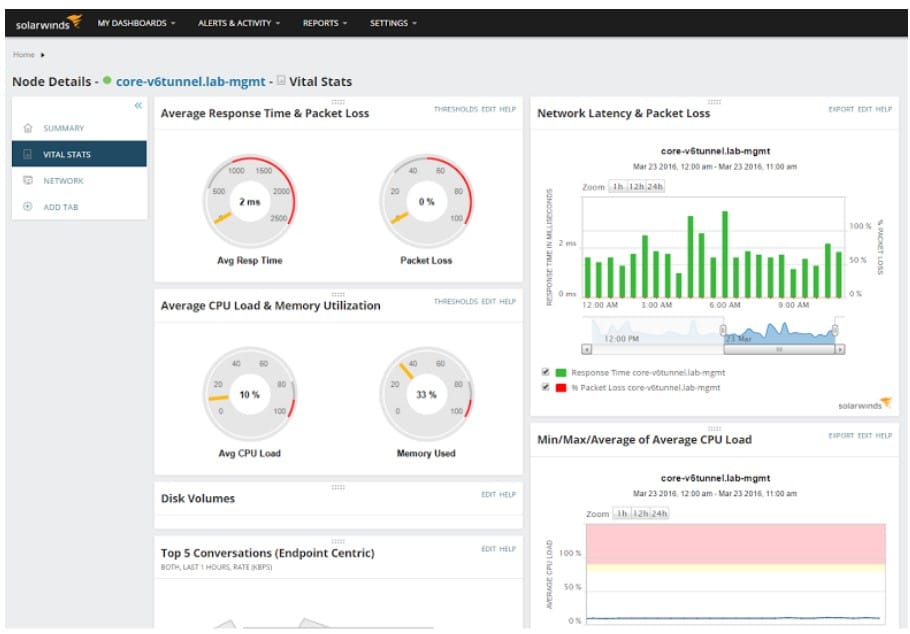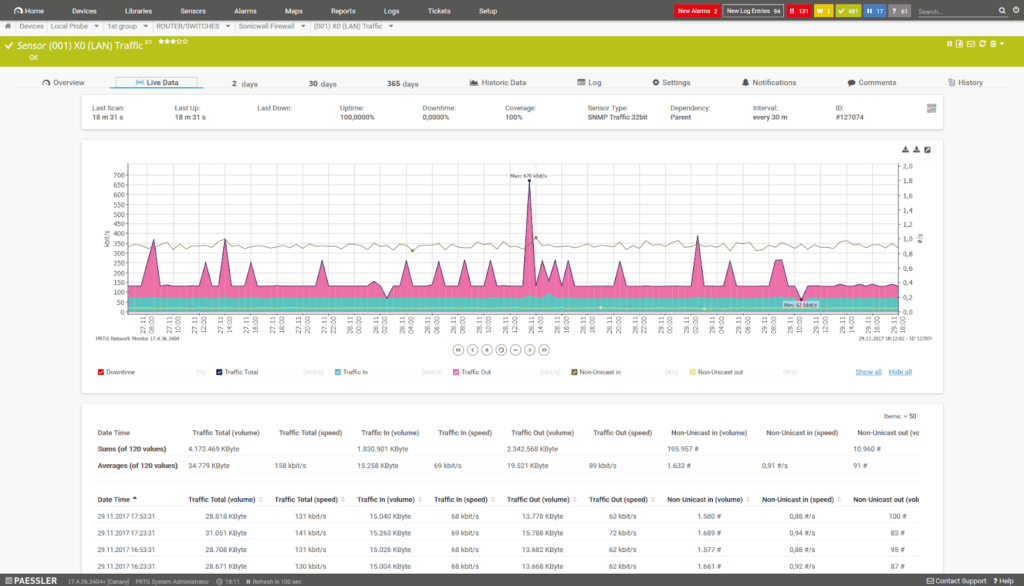Our funding comes from our readers, and we may earn a commission if you make a purchase through the links on our website.
8 Data Center Management Software & Tools for NOC Operations
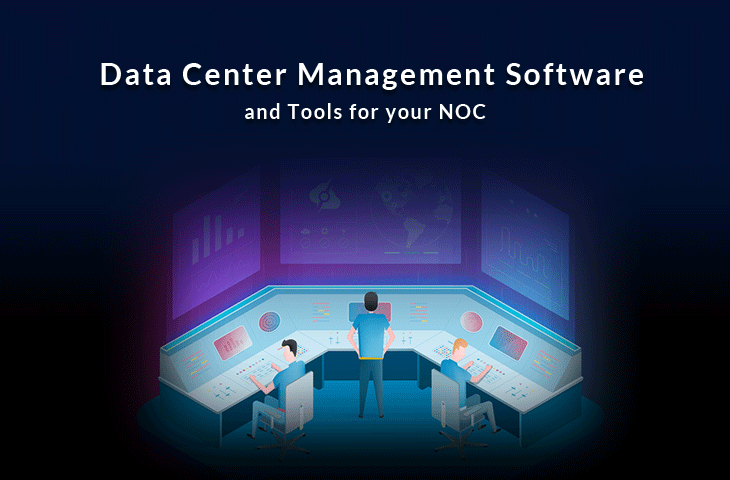
UPDATED: October 7, 2022
Data centers are complex and delicate environments. They are made of thousands of different components performing different operations, from servers, network devices, storage, virtual machines, to cooling and power units.
All components interconnected through underground or top-of-the-rack cabling and connected to power distribution units. IT managers & NOC Engineers struggle to keep control of every single detail in their data center infrastructure.
Most of the time, they are running their data centers with tools such as Excel and Visio. But running a sophisticated facility with a spreadsheet is a recipe for disaster.
Here is our list of the best Data Center Management Software for NOC operators:
- SolarWinds Network Performance Monitor – EDITOR’S CHOICE A platform of services that offer network and device monitoring with specialist modules for different equipment and services on your network. Buy all of the units or just select one or two to provide all your network monitoring needs. Runs on Windows Server. Start a 30-day free trial.
- Paessler PRTG Network Monitor – FREE TRIAL This bundle includes a large number of monitoring tools for networks, servers, and applications. You tailor the package by deciding which sensors to turn on. Runs on Windows Server. Start a 30-day free trial.
- ManageEngine OpManager A software package that provides monitoring tools for physical and virtual services on a network. Watch over your network devices and monitor your hypervisors with this package. Available for Windows Server and Linux.
- NLyte Software Watch over all of your data center infrastructure with this monitoring package that includes hardware and services performance tracking. This is a SaaS platform.
- Kaseya VSA This is a remote monitoring and management package (RMM) aimed at managed service providers that includes all of the technician tools needed to watch over and run the systems of clients. This is a SaaS platform.
- Device42 this system monitoring platform is centered around a discovery and mapping module that creates an asset inventory. Get live monitoring of all discovered devices with this virtual appliance that installs on cloud platforms, Citrix, VMWare, or Hyper-V.
- Zabbix This free system monitoring package covers networks, servers, and applications. It searches the network for all devices and creates a network topology map and then starts live monitoring. Runs on Linux.
- Nagios A monitoring package for networks servers, and applications that can be extended by thousands of free plugins. Available in free and paid versions, this package installs on Linux or on Windows over a hypervisor.
NOC Engineers need software capable of planning for capacity, inventorying, maximizing uptime, unifying visibility, automation, reporting, and more.
What is Data Center Management Software?
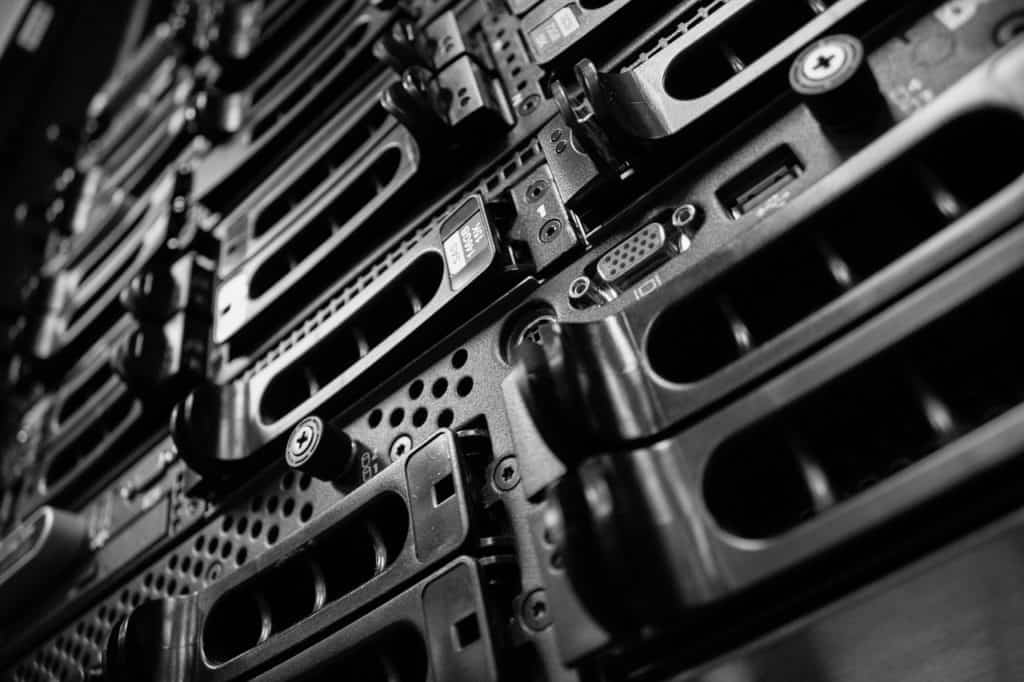
Data Center Management software allows admins to run their IT infrastructure efficiently, improve its uptime, and reduce costs.
This software is built to provide daily insights into the operations and health of the data center. Advanced management software can perform data center tasks automatically.
The software also provides a centralized platform for easy access and management of the infrastructure and services. It can help different IT departments within an organization such as DevOps, Infrastructure, Networking, etc. to collaborate and work from a single platform.
The most common type of data center management software is known as the DCIM (Data Center Infrastructure Management), which focuses only on the infrastructure. Other tools can be broader and provide information on other elements such as network, storage, virtual, applications. These same tools can also give you access to alerting, reporting, automation, and more capabilities.
Data Center Management Software Services:
On a basic level, data center management software should be capable of providing the following:
- Node details: Display device information such as status, vendor, IP, type, system name, etc.
- Unified visibility: Get a centralized view across all the elements in the data center.
- Layouts and maps: Get a graphical 2D or 3D representation of the data center room, its cabinet layout, and the cabling.
- Configuration and change: Document and monitor configuration and changes.
- Environment: Manage and monitor the power, and environmental factors of your data center.
- Automate processes: Automate common processes like scheduling, backups, compliance checks, node discovery, etc.
Other comprehensive data center management software can provide additional information that popular DCIM products cannot, such as:
- Network management: Monitor and manage different multi-vendor data center network technologies.
- Compute infrastructure: Manage your entire on-premises physical and virtual computing infrastructure.
- Manage storage: Keep track and control all your data center storage devices, such as DAS, NAS, or SAN.
- Manage applications: Keep control of your applications deployed in your data center.
- Reporting and alerting capabilities: Generate reports to gain insights into your data center and get alarms when there is a failure.
Best Data Center Management Software
Our methodology for selecting a data center management tool
We reviewed the market for data center management software and analyzed options based on the following criteria:
- Network, server, and application monitoring software
- Monitoring automation with alerts for system performance problems
- An easy-to-read dashboard with data interpreted into color-coded graphs and dials
- Integration between tools that can provide seamless data sharing
- The option to centralize the monitoring of multiple sites in one location
- A free trial or demo package that allows the system to be evaluated before buying
- Value for money from a comprehensive automated monitoring tool that will save the cost of staff
With these selection criteria in mind, we identified a number of data center management tools, including both on-premises and SaaS options.
1. SolarWinds Network Performance Monitor – FREE TRIAL
SolarWinds Network Performance Monitor (NPM) is one of the most comprehensive network monitoring and management tools in the market.
Its approach to data center monitoring is through a bundle of tools.
With this set of products from SolarWinds, you can gain full visibility into the computing, storage, VMs, infrastructure, and applications within your data center.
How SolarWinds Can Help you manage your Data center:
- Network Performance Monitor for network monitoring,
- Network Configuration Management for automatic network configuration management and backups,
- Virtual Manager for VM monitoring and performance optimization.
- Storage Resource Monitor for storage management and performance monitoring.
With SolarWinds, you can get end-to-end management and monitoring for your entire data center, from a single console.
Key Features:
- Out-of-the-box reporting.
- Automated configuration and change management.
- Network health and performance monitoring.
- Physical and virtual infrastructure management.
- Manage data center environmental monitoring.
- And a lot more.
You can get all those SolarWinds tools, integrated into a central and single platform, and get a unified overview of all your components in the data center.
Pros:
- Supports auto-discovery that builds network topology maps and inventory lists in real-time based on devices that enter the network
- Has some of the best alerting features that balance effectiveness with ease of use
- Supports both SNMP monitoring as well as packet analysis, giving you more control over monitoring than similar tools
- Uses drag and drop widgets to customize the look and feel of the dashboard
- Tons of preconfigured templates, reports, and dashboard views
Cons:
- This is a feature-rich enterprise tool designed for sysadmin, non-technical users may some features overwhelming
EDITOR'S CHOICE
SolarWinds Network Performance Monitor and related tools on the SolarWinds Orion platform create our top pick for a network operation center package because it gives you all of the monitoring and network management software that you need to automate your IT operations tasks. While the network performance monitor watches over network devices, you can add on traffic analysis with the NetFlow Traffic Analyzer. If you have virtualizations on your system, get the Virtualization Manager. The SolarWinds Storage Resource Monitor will watch over your storage devices and the Network Configuration Manager standardizes and locks in the settings of all of your network devices.
Download: Start 30-day Free Trial
Official Site: https://www.solarwinds.com/npm-ncm-nta/registration
OS: Windows Server
2. Paessler PRTG Network Monitor – FREE TRIAL
PRTG Network Monitor is another comprehensive network monitoring and management solution. It is one of the most popular and well-known products on the market.
Key Features:
- Monitor applications and services hosted in your data center.
- Keep track of your data center environment.
- Unified monitoring solution for thousands of different vendors.
- Receive automatic alerts and notifications.
- Generate in-depth data center reports.
PRTG Network Monitor can keep an eye on every component of your data center, from servers, the network, systems, traffic, applications, VMs, hardware, etc. PRTG is based on monitoring sensors. Each sensor keeps track of a component within a device, such as CPU, latency, memory, etc. Sensors can also monitor overall aspects in the network, like traffic, bandwidth, environment, etc.
Pros:
- Uses a combination of packet sniffing, WMI, and SNMP to report network performance as well as discover new devices
- Autodiscovery reflects the latest inventory changes almost instantaneously
- Drag and drop editor makes it easy to build custom views and reports
- Supports a wide range of alert mediums such as SMS, email, and third-party integration
- Supports a freeware version
Cons:
- Is a very comprehensive platform with many features and moving parts that require time to learn
- Custom sensors can sometimes be challenging to manually configure
Price: The price for PRTG500 starts at $1,600. PRTG500 allows you up to 500 monitoring sensors and one server installation.
Download: Free PRTG100 available for up to 100 sensors. You can also download a 30-day free trial with unlimited sensors.
3. ManageEngine OpManager
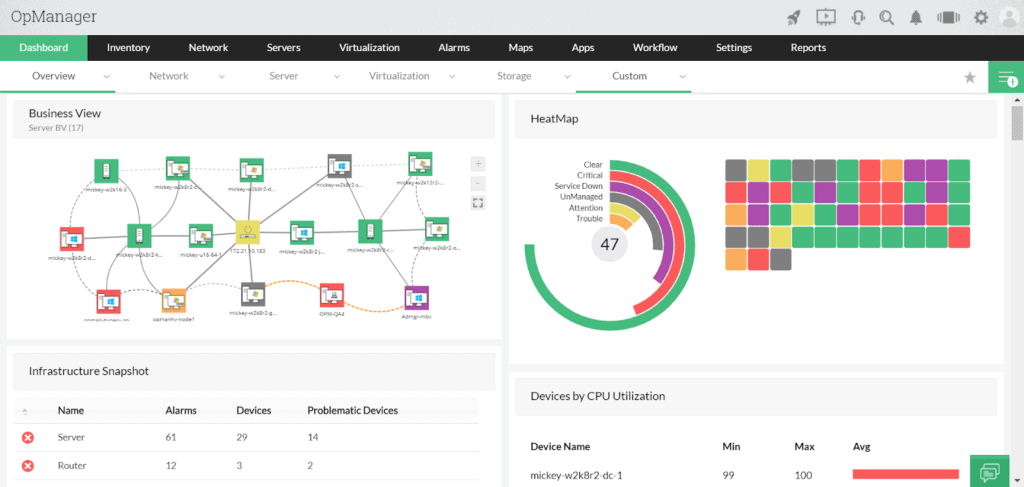
ManageEngine OpManager is a popular network monitoring and management solution. It can help you keep track of all devices within a data center, from routers, switches, firewalls, wireless APs, VMs, etc. OpManager monitors your data center’s network and provides a complete overview and control.
How OpManager Enterprise Edition can help you manage your Data Center:
- Proactively monitor physical & virtual servers.
- Keep track of applications and bandwidth with Applications Manager.
- Monitor flow-based traffic.
- Check data center environment.
- 3D data center flooring views.
When there is a fault, OpManager can provide root cause analysis, so that you can solve the issue before they affect the end-user. The OpManager Enterprise Edition offers a comprehensive data center management. The unified web console helps you gain visibility over the entire data center, scale up as needed, and send automatic health reports.
Pros:
- Designed to work right away, features over 200 customizable widgets to build unique dashboards and reports
- Leverages autodiscover to find, inventory, and map new devices
- Uses intelligent alerting to reduce false positives and eliminate alert fatigue across larger networks
- Supports email, SMS, and webhook for numerous alerting channels
- Integrates well in the ManageEngine ecosystem with their other products
Cons:
- Is a feature-rich tool that will require a time investment to properly learn
Price: OpManager is available in four editions, Free, Essential, Enterprise, and Service Packs. For more information request a quote.
Download: Get a free trial of OpManager Enterprise Edition for 30-days and start monitoring and managing up to 10K devices or 100K interfaces in your data center.
4. NLyte Software
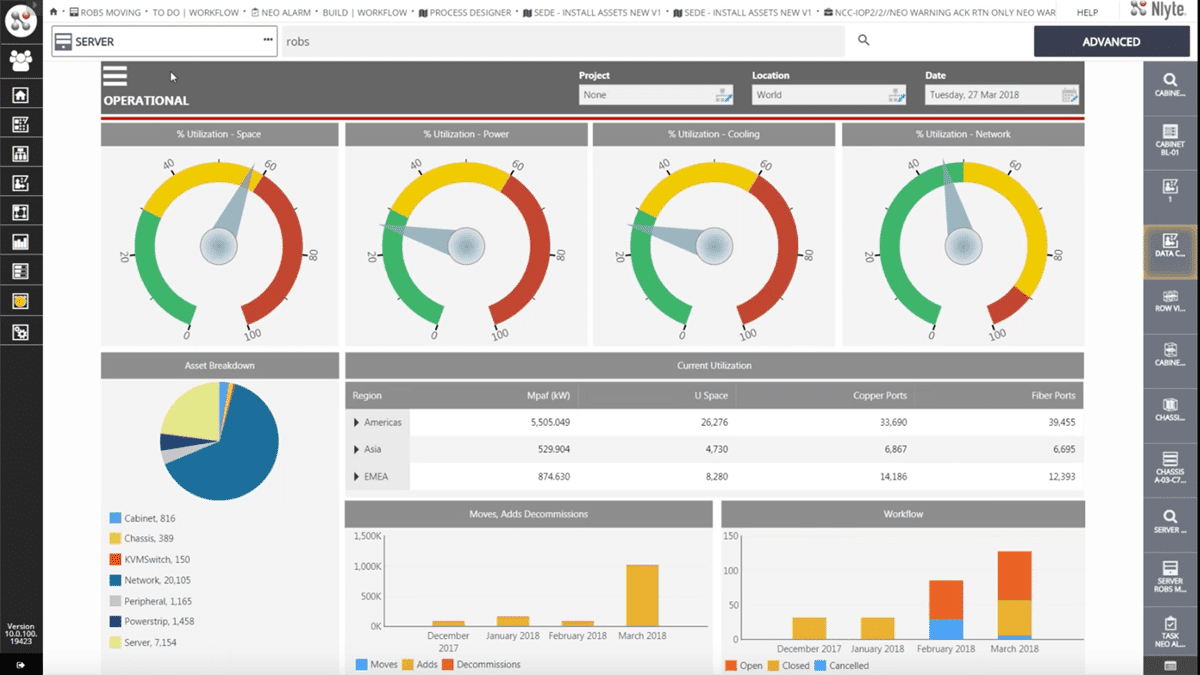
Nlyte Software is a popular DCIM tool that focuses on the management, planning, and optimization of your data center. The software can help maintain physical, virtual, or edge environments within a data center and optimize their utilization.
Key Features:
- Computing infrastructure management.
- Asset lifecycle management.
- Comprehensive dashboards and reports.
- Capacity planning.
- Real-time data collection.
Nlyte software keeps a detailed inventory of your data center assets and monitors the environment. The auto-discovery process maintains an updated list of all equipment, and it also tracks changes in the configuration. The software comes with powerful automation capabilities. It can automate processes such as the discovery of nodes, asset management, workflows, and reporting.
Pros:
- Sleek user interface
- Offers capacity planning tools
- Collects and displays metrics in real time
- Ideal for larger enterprises or data centers
Cons:
- Would like to see a longer trial period
Price: For pricing information on the DCIM’s Nlyte product, request a quote.
Download: Request a 14-days free trial of Nlyte and start optimizing your data center assets.
5. Kaseya VSA

Kaseya VSA is a SaaS-based remote IT management and monitoring software designed for large data centers in Managed Service Providers (MSPs), SMBs, and IT enterprises. Kaseya VSA was named in 2016 as one of the top 20 Data Center Tool Providers, by CRN.
Kaseya’s VSA data center management features:
- Network and endpoint management.
- Audit and asset inventory.
- Deploy policy-based automation.
- Proactive remediation.
- Automate software and patching deployment.
- Anti-malware and anti-virus.
This software is capable of supporting, managing, and protecting complex and large data centers. With Kaseya VSA, you can manage the data center infrastructure, including the network and its endpoints, and scale up with its powerful automation functionality. Its unified web console allows you to view the entire data center from a single centralized platform.
Pros:
- Automated software deployments can help streamline adding new machines to the client network
- Does a good job at monitoring overall health and resource consumption of devices
- Interface is simple and customizable
Cons:
- The free trial could be longer
Price: The price of KaseyaVSA is based on the number of endpoints. For more information, request a quote.
Download: Get a 14-day free Kaseya VSA Trial and start managing your data center
6. Device42
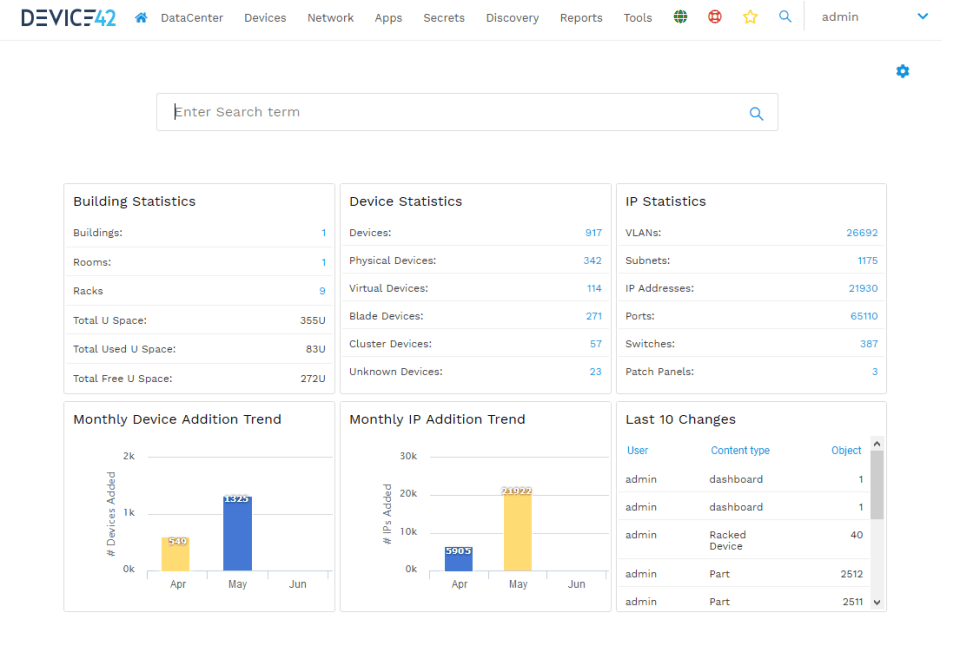
Device42 is a comprehensive DCIM and network management solution. It comes with powerful data center visualization tools that produce smart data center diagrams and layouts.
With its CMDB (Configuration Management Database) feature, Device42 can also provide an overview of all your configuration items so that you can easily manage them.
Key Features:
- Insights into the computing environment.
- Application dependency mapping.
- Software license management.
- Agentless and continuous device discovery.
- Power and environment management.
- Data center room and cabling.
The software comes with IT asset management capabilities. The auto-discovery feature finds all nodes in the data center, from on-premises, virtual, or cloud. When the tool finds assets, it includes them in the inventory where you can change their details. Device42 allows native integrations with lots of popular applications used in managing IT Infrastructure.
From tools like JIRA, Slack, Logstash, Zapier, Ansible, Puppet, Chef, and more.
Pros:
- Can produce automatic topology maps as well as dependency mapping
- Offers a unique rack-level visualization to help on-site technicians map physical infrastructure to certain services
- Designed to scale in enterprise environments
Cons:
- Would like to see it easier to create custom affinity groups
Price: The license for Device42 is based on an annual subscription. The pricing tiers vary according to the number of managed devices.
Device42 Core version has an annual price of $4500 and allows you to manage up to 500 devices and up to 5000 IPs.
Download: Get a free trial of Device42
7. Zabbix
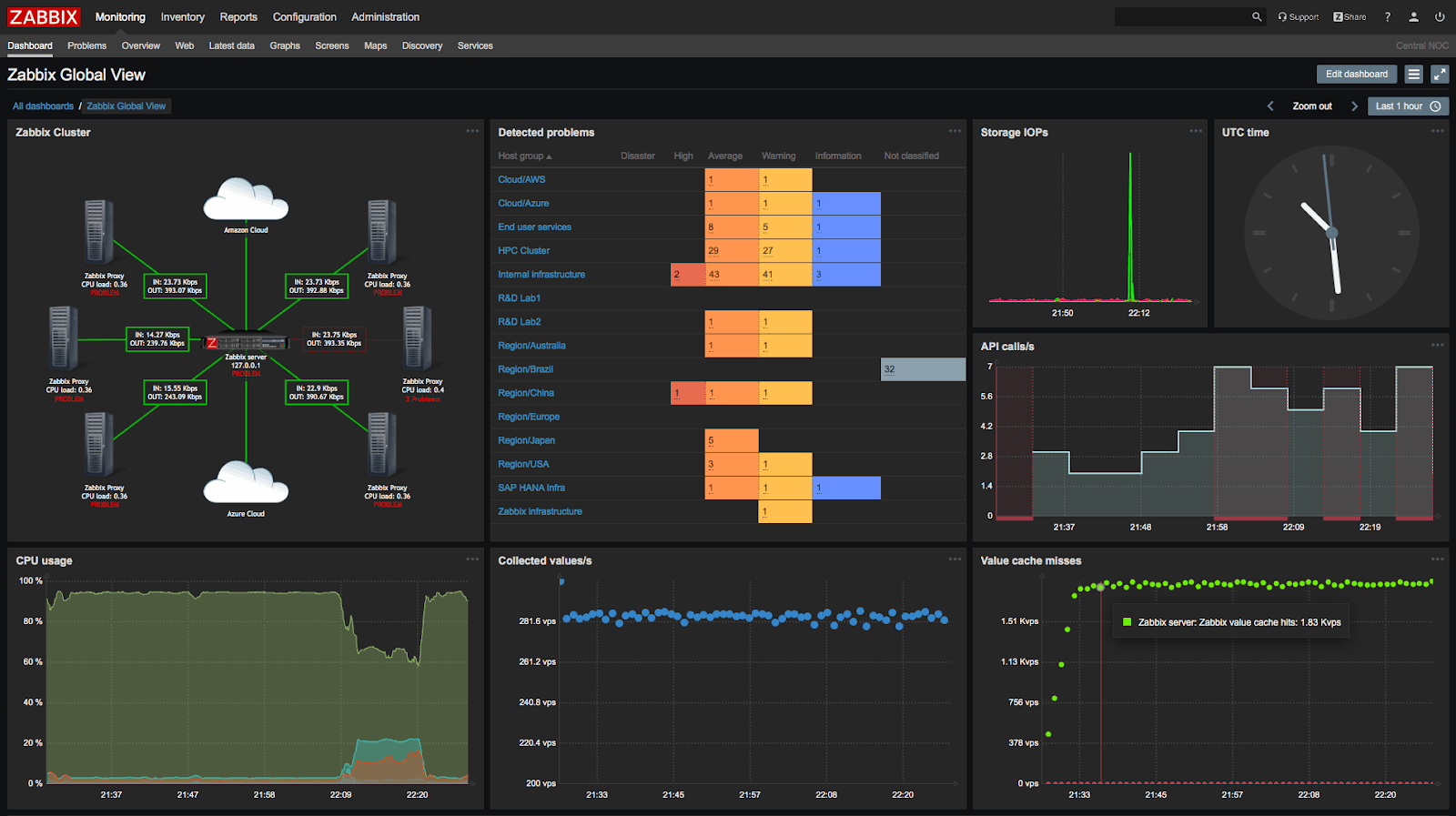
Zabbix is a free and open-source IT Infrastructure management and monitoring software. It helps you control any component of your data center, from servers, network, VMs, databases, storage, applications, and more.
How can Zabbix help you manage your data center?
- Distributed Monitoring: Monitor remote data centers or branch offices.
- Agentless high-performance monitoring. Keep track of different elements in your data center without any agents.
- Integrations: Out-of-the-box integrations of popular vendors, like Cisco, D-Link, Juniper, HP, Netgear, Huawei, and more.
Zabbix is one of the only open-source products that can scale from small to large environments. Its features allow monitoring up to 100,000 hosts simultaneously. Zabbix shows an overview of the IT environment from a single, visually appealing pane-of-glass.
Its native web interface integrates all visuals, from dashboards, graphs, network maps, slideshows, reports, alarms, etc.
Pros:
- Open-source transparent tool
- Uses both SNMP and ICMP for a broader monitoring range
- Can detect new devices and configuration changes immediately
- Offers useful templates for quick insights
- Robust notification system supports SMS, email, custom script, and webhook
Cons:
- Better suited for small to medium-sized businesses
Price: Zabbix is a free and open-source software. If you want to manage large scale data centers, Zabbix Enterprise edition might be the best solution. For more information on prices, request a quote.
Download: Get the free Zabbix open-source and start managing smaller data centers for free!
8. Nagios
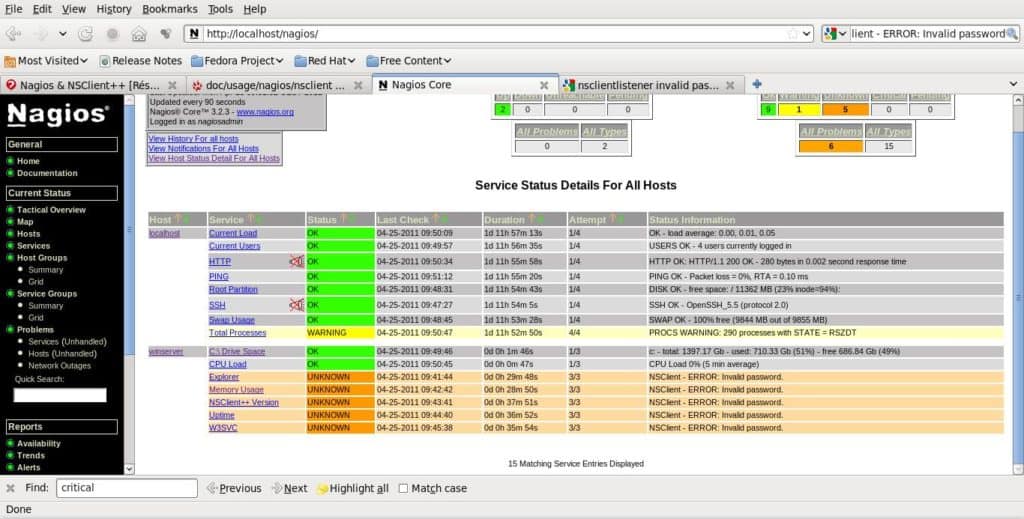
Last but not least is Nagios. This solution has become one of the preferred data center management software for companies looking for an open-source platform. Nagios can monitor many different components in your data center, from routers, switches, servers, storage, data center environment, VMs, etc.
Nagios Core is a free and open-source community-driven monitoring and alerting platform. The engine of Nagios Core serves as a primary application where hundreds of projects are built. The tool comes with nearly 4000 third-party plugins, which are standalone extensions that provide extra intelligence for managing anything within your data center.
Key Features:
- It monitors single points of failure.
- It finds and monitors SLA faults.
- It manages servers and their connections.
- It monitors environmental factors such as temperature and humidity.
Out-of-the-box, Nagios Core does not have a dashboard and a Graphical User Interface (GUI).
But you can install a GUI from the list of plugins. Nagios XI, which is the commercial version has extra features like reporting, web interface, diverse monitoring capabilities, and more. Nagios was created for Linux operating systems, but it can also run on Windows using extensions such as Check_MK or Nagwin.
Pros:
- Open-source transparent tool
- Simple, yet informative interface
- Flexible alerting options support SMS and email
- Robust API backend makes it a great option for developers who want to integrate their own custom applications
Cons:
- The open-source version lacks quality support found in paid products
- Installation can be complex compared to competing products
Price: Nagios Core is free and open-source software. The Nagios Core XI price starts at $1,995 for a single standard license.
Download: Get a Nagios Core, or get a 60-days free trial version of Nagios XI.
Summary
Data centers are complex facilities. Some of them have hundreds to thousands of devices interconnected together through networking equipment and endless cabling. But networking is not the only player in a data center; there are servers, firewalls, storage appliances, cooling and power systems, and more.
Some superhero IT managers are capable of keeping these sophisticated environments in place, through spreadsheets and diagramming apps, but the sky has a limit. The DCIM and the broader data center management tools will help you automate processes, improve uptimes, keep things organized, plan for capacity, AND MORE!
There are way too many benefits in these platforms that it is hard to continue using traditional administration solutions. Most of these tools have free versions of their software, and some others have fully-featured free trials for a limited time. So there is no excuse to start managing your data center today!
Data Center Management Software FAQs
What is data center management system?
A data center can be an in-house department or a managed service. The center provides IT services for other departments in the business or other businesses. Typically, a data center will support multiple sites and only be contactable via email, phone, or ticketing system. The data center needs to manage infrastructure and applications.
What is data center monitoring?
Data center monitoring involves watching over the performance of networks, servers, and applications. These facilities are used by a business and the data center is either an in-house department or a managed service provider’s organization. The data center staff needs to ensure that infrastructure and applications perform sufficiently well that the users of the system can continue to perform their work. This task requires catching problems before they evolve and automated monitoring tools provide this service.
What is data center infrastructure?
Data centers can provide physical equipment for businesses, such as servers. The data center also needs to connect those servers to the users and this involves both a local network and internet connections. These utilities together form the infrastructure of the data center.

